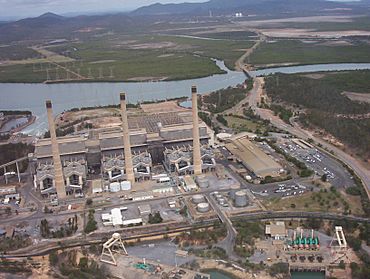Callemondah facts for kids
Quick facts for kids CallemondahGladstone, Queensland |
|||||||||||||||
|---|---|---|---|---|---|---|---|---|---|---|---|---|---|---|---|

Gladstone Powerhouse with the Calliope River beyond, 2005
|
|||||||||||||||
| Population | 18 (2016 census) | ||||||||||||||
| • Density | 0.352/km2 (0.91/sq mi) | ||||||||||||||
| Postcode(s) | 4680 | ||||||||||||||
| Area | 51.1 km2 (19.7 sq mi) | ||||||||||||||
| LGA(s) | Gladstone Region | ||||||||||||||
| State electorate(s) | Gladstone | ||||||||||||||
| Federal Division(s) | Flynn | ||||||||||||||
|
|||||||||||||||
Callemondah is a small suburb located right on the coast in Gladstone, Australia. It's part of the Gladstone Region in Queensland. Even though it's small, Callemondah is a very important area for industry and transport.
Contents
What is Callemondah Like?
Callemondah is mostly an industrial area. This means you'll find many large factories and facilities here. It's a key place for moving coal and other goods.
Rivers and Waterways
The Calliope River flows along the south-western edge of Callemondah. It then goes north through the suburb and into Gladstone Harbour. Another waterway, Auckland Inlet, forms the eastern border. This inlet separates Callemondah from the main part of Gladstone.
Big Industries and Power
Callemondah is home to several large coal port facilities. These are places where coal is stored and loaded onto ships. You'll also find the NRG Gladstone Powerhouse here. This is the biggest power station in all of Queensland! Many other industrial businesses also operate in Callemondah.
Train Connections
The Callemondah railway station is on the southern side of the suburb. This station is a major hub for trains. It connects to several important railway lines, including the North Coast railway line. There are also private train lines within Callemondah that serve the different factories and businesses.
Where Did the Name Callemondah Come From?
The name Callemondah comes from its railway station. In August 1967, Queensland Railways Department named their train servicing facility "Callemondah". The name is an Aboriginal word, likely from a New South Wales area. It means "plenty of hills".
Learning in Callemondah
Central Queensland University has a campus in Callemondah. It's called the Gladstone Marina campus. This campus is located in the north-east part of the suburb, right next to the Gladstone Marina. A bridge connects this area to Gladstone Central.
Fishing Fun at Lake Callemondah
Lake Callemondah is a special artificial lake in the suburb. It's next to Auckland Inlet but separated by a wall. This lake collects stormwater run-off from local roofs and streets.
Barramundi in the Lake
In 1999, young barramundi fish, called fingerlings, were first put into the lake. As these fish grow bigger, they can swim out into Auckland Inlet and beyond. About 2,800 new fingerlings are added to the lake every year. Scientists tag the fish to track them. They've found that most of the grown fish stay in the Gladstone area. However, one barramundi was found 36 kilometres away in the Boyne River!
Images for kids



